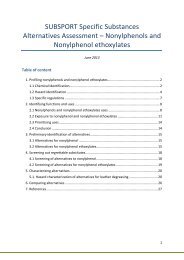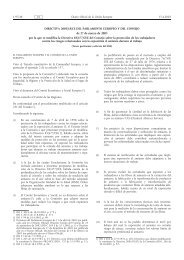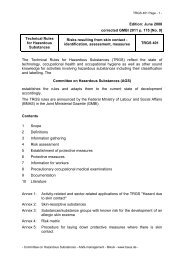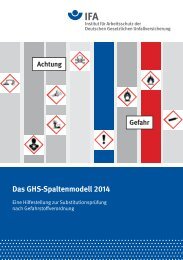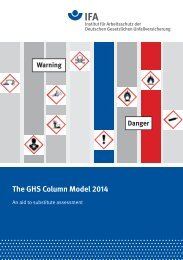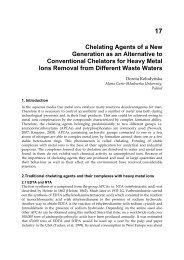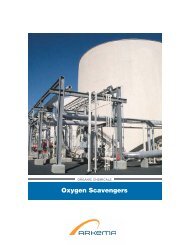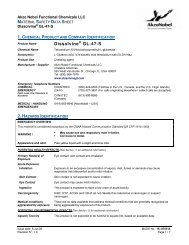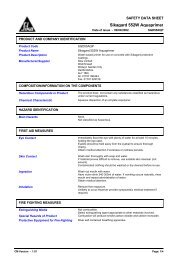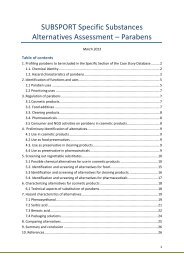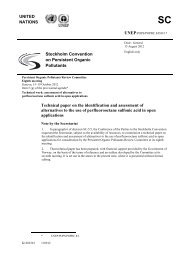Dissolvine® GL Technical brochure - AkzoNobel
Dissolvine® GL Technical brochure - AkzoNobel
Dissolvine® GL Technical brochure - AkzoNobel
Create successful ePaper yourself
Turn your PDF publications into a flip-book with our unique Google optimized e-Paper software.
Dissolvine ® <strong>GL</strong> <strong>Technical</strong> Brochure 7<br />
Table 3: Sequestering values (mg/g product) Dissolvine ® <strong>GL</strong> (<strong>GL</strong>DA), Dissolvine ® A-40 (NTA)<br />
and Dissolvine ® E-39 (EDTA) for several metal ions and CaCO 3<br />
.<br />
Product Assay (wt%) CaCO 3<br />
Ca 2+ Cu 2+ Fe 3+ Mg 2+ Mn 2+ Zn 2+<br />
Dissolvine ® <strong>GL</strong>-38 38 108 43 69 60 26 59 71<br />
Dissolvine ® <strong>GL</strong>-47-S 47 134 54 85 75 33 73 88<br />
Dissolvine ® A-40 40 156 62 99 87 38 85 102<br />
Dissolvine ® E-39 39 103 41 65 57 25 56 67<br />
Chelating power<br />
Chelating agents are added to products or processes to control metal<br />
ions. For example, in cleaning and personal care chelating agents are<br />
used to soften the water by complexing calcium and magnesium ions,<br />
whereas in other applications chelates are used to remove unwanted<br />
scale by complexing the scale metal ions. In an application such as metal<br />
plating, chelates are used to deliver the metal ions in just the precise<br />
form. For every application, it is important to select a chelating agent that<br />
is sufficiently strong to be able to do the job. An indication of the affinity<br />
a chelate has for a certain metal can be derived from the dissociation<br />
constants, stability constants and conditional stability constants.<br />
The stability or equilibrium constant (K), generally expressed as log K, is<br />
an indication of the strength of the complex formed between the metal<br />
ion and the chelating agent. The higher the log K values, the more tightly<br />
the metal ion will be bound to the chelating agent and the more likely it is<br />
that the complex will be formed, see Table 4.<br />
The pH of the system and the oxidizing nature of the environment can<br />
affect the stability and effectiveness of the chelating system. For each<br />
metal complex there is an optimum pH and an active pH range in which<br />
the metal complex is stable. The conditional stability constant (log K’)<br />
is an indication of the stability of the complex as a function of the pH,<br />
see Figure 7.<br />
Table 4: Stability constants (log K values)1 and active pH range for<br />
Dissolvine ® <strong>GL</strong> (<strong>GL</strong>DA).<br />
Metal ion Ca 2+ Cu 2+ Fe 3+ Mg 2+ Mn 2+ Zn 2+<br />
Log K 5.9 13.1 11.7 2 5.2 7.6 2 10.0 2<br />
Active pH range 3 6-14 2-12 4 2-8 4 7-10 5-10 4 3-12 4<br />
Figure 7: Theoretical curves of the conditional stability constant (log K’) of <strong>GL</strong>DA<br />
for various metal ions as a function of pH (1:1 metal:chelate complex).<br />
Experimental data show that the calcium affinity of <strong>GL</strong>DA in practical<br />
applications is much higher than would be expected based on the<br />
artificially obtained conditional stability constant as is clearly shown in the<br />
chapter on functionalities in applications, Figure 9. A separate application<br />
leaflet (no. 291) on calcium affinity of chelates is available on request.<br />
The quantity of chelating agent needed depends on the concentration of<br />
metal ion to be chelated and the type of chelating agent used. Dissolvine ®<br />
products generally chelate on an equimolecular basis (i.e. the higher<br />
the molecular weight of the chelating agent, the higher the quantity of<br />
chelating agent required to chelate the metal ion). The chelating capacity<br />
of Dissolvine ® <strong>GL</strong> -38 and <strong>GL</strong>-47-S are compared to two commonly used<br />
products in Table 3, at the top of this page.<br />
1<br />
A.E. Martell, R.M. Smith, NIST Critically selected stability constants of metal<br />
complexes (NIST standard reference database 46, Version 7.0, 2003);<br />
Log K values as determined at an ionic strength of 0.1M and at a temperature<br />
of 25°C.<br />
2<br />
As determined by <strong>AkzoNobel</strong>; Log K values as determined at an ionic<br />
strength of 0.1M and at a temperature of 25°C.<br />
3<br />
Active pH range: calculated for a hydroxide environment in de-mineralized<br />
water at 0.1 mol/l. Lower pH limit: the conditional stability constant logK' ≥ 3.<br />
Upper pH limit is based on the precipitation of the metal hydroxide; at upper<br />
pH limit the fraction chelated ≥ 95%.<br />
4<br />
Upper pH limit is determined experimentally.




